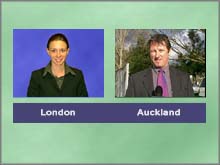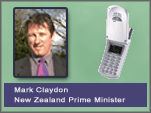Remote Interviews

In a remote interview the interviewer is geographically separated from the guest. Transmission equipment enables the interview to take place in real time, either for live broadcast or recording. Remote interviews can occur between two studios, between a studio and temporary field location, or between two field locations.
The signature of the remote interview is the split screen (pictured right). This establishes both locations and provides comfortable transitions between them.
As you can imagine, the remote interview has numerous technical and logistical complications. Before the interview begins the following preparations must be made (in addition to normal preparations):
- Establish transmission and communication links between locations, and complete technical checks.
- Prepare the guest for the interview (see below).
- Sometimes vision monitors are set up so the participants can see each other, but this isn't usually necessary (or even desirable as it can be distracting for the guest).
- The cameras in each location must be matched in composition, colour balance, etc. It's not a good look when one head is much bigger than the other.
Preparing the Guest
How you prepare the guest will depend on the their level of experience. If they are new to this type of interview they will need to be well briefed. It is a difficult and unnatural situation and not everyone will cope.
The guest will need to be rigged with a microphone and earpiece. While this is happening, explain briefly how things work and what to expect. If a hand-held mic is being used, make sure the guest knows how to use it. If possible, let the interviewer and guest have a short preparatory conversation before the actual interview begins. This ensures they are both comfortable with each other's audio level and quality, and helps relax the guest.
Useful advice for the guest includes:
- "The interview will be similar to a telephone conversation."
- "Look straight at the camera. Imagine the camera lens is a small window through which you and the interviewer can see each other."
(This is because many people tend to look aimlessly toward the ground or sky as they talk. If they feel more face-to-face with the interviewer they are more likely to keep looking in the right direction).
The Interview Sequence
The interview sequence will typically begin like this:

- Full-screen shot of the interviewer with their preamble.
- As the interviewer begins introducing the guest (e.g. "I'm joined from Auckland by..."), a split screen is shown between interviewer and guest. Titles below each person identify the the respective locations.
- Shortly after the guest begins answering the first question, their shot is shown full screen.
- The guest's name/title key is shown.
The interview can then comfortably cut between the two full-screen shots, just as if the two people were sitting next to each other in the same studio. Occasionally the split screen is cut in to remind viewers of the situation and to allow the interviewer and guest to interact together on screen.
Telephone and Audio-Only Interviews

A simpler version of the remote interview can be conducted by telephone. This is often referred to as a phone-in interview.
A graphic is prepared like the one on the right, which includes a picture of a telephone or some other icon which makes it obvious what's happening. If possible, use a photo of the guest. The graphic is then used when the guest is speaking (i.e. in place of video shots).
This technique can also be used with normal transmission equipment if for any reason video is not available.
New Technologies
These days remote interviews can also be conducted via mobile video phones. This is desirable in situations where equipment and personnel must be kept to the bare minimum, or when resources are spread very thinly. The most well-known examples are during wartime operations when reports are filed from many journalists in difficult locations.
Expect this type of remote interview to become very common as the technology improves.
Next Page: Vox Pops